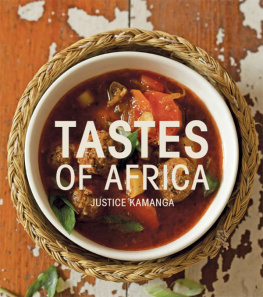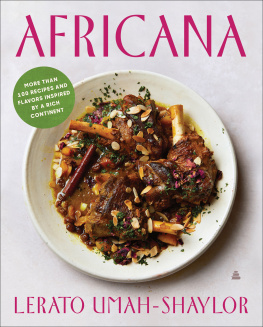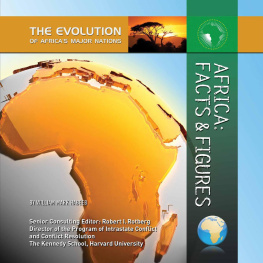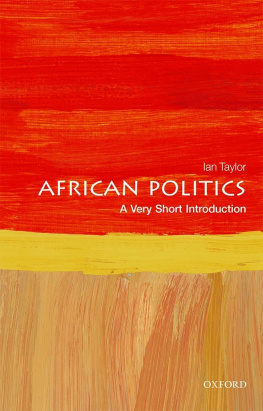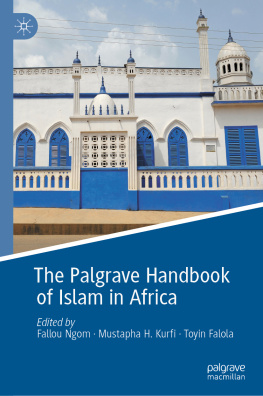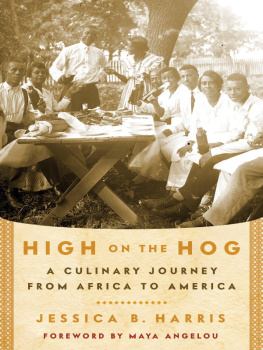
ACKNOWLEDGEMENTS
I would like to thank all those people who worked so hard to make this exciting and amazing book possible. It has been a dream come true for me and what my eyes have seen, my heart cannot believe. It has been a pleasure working with all of you: Linda, Beverley and Cecilia at Random House Struik, as well as photographer Ryno, and Brita and Jen.
I would also like to thank my special family for all their love and support: Roseleena, Kevisto, Isaack, Alucia, Leeare, Johnson, Justice jnr, Devison and Wesley.
Furthermore, I would like to thank my friends Wade, Tanith, Gavin, Lynne and Louise for everything they have done.
I hope you enjoy cooking these recipes as much as I have.
JUSTICE KAMANGA
The publishers would like to thank the following suppliers for their generous loan of props: Mnandi Textiles, Moroccan Warehouse, Out of this World, and Heartworks.
Published in 2010 by Struik Lifestyle (an imprint of Random House Struik (Pty) Ltd)
Company Reg. No. 1966/003153/07
Wembley Square, First Floor, Solan Road, Gardens, Cape Town, 8001
PO Box 1144, Cape Town, 8000, South Africa
This ebook published in 2012
Copyright in published edition: Random House Struik (Pty) Ltd 2010
Copyright in recipes: Justice Kamanga 2010
Copyright in introduction text: Random House Struik (Pty) Ltd 2010
Copyright in photographs: Random House Struik (Pty) Ltd 2010
All rights reserved. No part of this publication may be reproduced, stored in a retrieval system or transmitted, in any form or by any means, electronic, mechanical, photocopying, recording or otherwise, without the prior written permission of the publishers and the copyright holders.
Print ISBN 978-1-77007-802-4
Epub ISBN 978-1-43170-283-1
PDF ISBN 978-1-43170-284-8
PUBLISHER: Linda de Villiers
EDITOR: Cecilia Barfield
DESIGNER: Beverley Dodd
INTRODUCTION TEXT: Gavin Barfield
BACKGROUND RESEARCH: Lynne Harris
PHOTOGRAPHER: Ryno
STYLIST: Brita du Plessis
FOOD PREPARATION: Jen du Plessis
PROOFREADER AND INDEXER: Joy Clack
CONTENTS
INTRODUCTION

INTRODUCTION
No matter how up-to-date, no book on African food can ever be complete. Just as the sprawling continent is itself a work in progress, so too is its cuisine in a process of flux and evolution.
The second-largest land mass on earth and home to hundreds of tribes, ethnic and social groups, Africas diversity is reflected in its cuisine; in the use of inexpensive, basic, locally-available ingredients, as well as in the widely-differing cooking techniques and styles of preparation. Given the sheer size of the continent, the current vogue for African food means that no dish can ever be generic.
Common to many parts of the continent are meals with little meat, plenty of whole grains and beans, and fresh fruits and vegetables. In an increasingly health-conscious society, African cuisine may well become the new healthy way of cooking.
African cooking varies widely from one part of the continent to another. North, Southern, Central, East and West Africa all have their trademark dishes. This is fusion food easily-prepared, readily-available foods that people eat now, subtly influenced by traditional African dishes. In this book you will realise how easily you can have an authentic, African-themed dinner party at home, using modern foods we eat every day, but given an easy and intriguing African slant.
While there have been many books dealing with the traditional cuisine of individual African countries, often following the fickle whims of culinary fashion, in bringing you this book Justice Kamanga reaches beyond the single-country approach to the broad essence of African cooking and takes you on a beguiling epicurean journey through the continent to the soul of its cuisine.
Just as Africa is often an enigma to the traveller, so its cuisine paradoxically, perhaps is deceptively simple, yet at the same time complex and unknowable in the antiquity of its ingredients, origins and preparation methods that have remained unchanged for more than a thousand years.
The tastes and flavours of Africa evoke the continent itself, relatively unknown to those who havent visited it, or who have only done so on a hectic in-and-out business or holiday trip that never leaves the time to dig beneath the ersatz safari ethos to the roots of its culture and traditions.
You will discover the origins of many favourite dishes, united both by a disarming honesty and ease of preparation, and find that each fascinating flavour and intriguing new texture comes subtly through the taste of the whole, from the most caustic of curries to soothing cucumber- and yoghurt-based antidotes designed to put out the fire!
Rural sea and lakeshore folk in Africa, accustomed to eating some fairly alarming-looking things from time to time, drew the line at having a beady eye ogling them from the aromatic, saffron-hued depths of their soup. When the fishermen returned from their labours at the end of the day, locals waiting on the shore to buy their catch usually asked for the heads to be taken off. This left the vendors with a cargo of fish-heads looking up at them accusingly from the bottom of the boat. Since this is a practical land where nothing is wasted, the heads ended up in the soup, although they are always removed before serving. A few imaginative, locally-available bits of this and that were added to the fish-heads simmering in the communal stockpot, and the eventual result was a piscatorial potage of majestic quality. Traditionally, when available, shellfish also found their way into the soup pot, and theres a sublime crayfish soup included with the recipes thats ideal for serving as a starter before a main meat or curry dish.
A quick word on the subject of fish, though to support conservation initiatives, before buying any fish or seafood, it is always best to check that what youre buying is on the approved green list (best choice), or at least on the orange list (caution) of SASSI (the Southern African Sustainable Seafood Initiative see http://www.wwfsassi.co.za).
Central Africa, the region whose cuisine has perhaps been least influenced by the outside world, stretches from the Tibetsi mountains in the North to the basin of the Congo River, the second-largest river in Africa. Apart from the cassava, peanut and chillipepper plants, which arrived there via the slave trade in the early 1500s, historically the relatively inaccessible regions cooking has resisted outside influences. Like other parts of Africa, however, the cuisine of Central Africa still relies heavily on dishes containing cassava or plantains.
The determinedly stodgy fufu, for example, is probably the best-known Central African staple, particularly in Cameroon, where it is sometimes called Couscous de Cameroon (although it bears no resemblance at all to the exalted Moroccan product of the same name). Similar to pap in South Africa, sadza in Zimbabwe and ugali in Kenya, its a sort of stiff porridge, made out of starchy root vegetables. Normally beaten with a mortar and pestle until the desired consistency is reached, fufu is often eaten with okra, dried fish or tomato, and goes well with palm-nut or groundnut (peanut) soup. Central African countries are hot on their soups; among the best are those made with either smoked or unsmoked meat or fish. The eater breaks off a piece of
Next page
